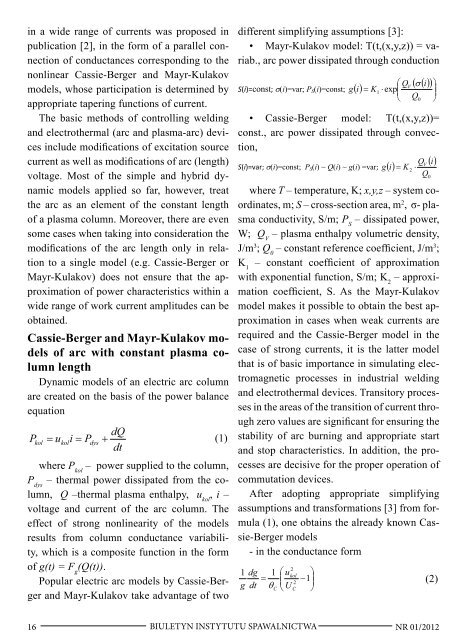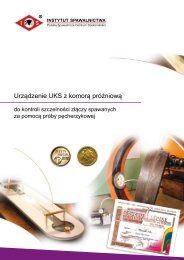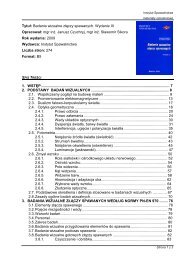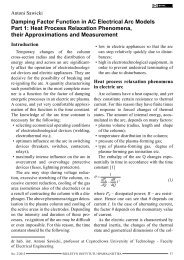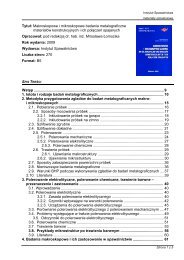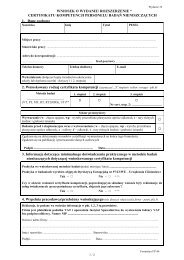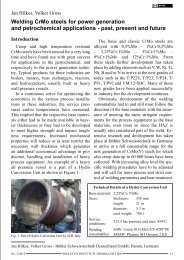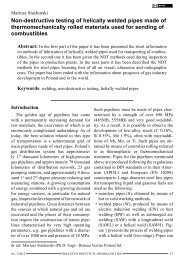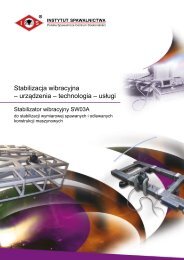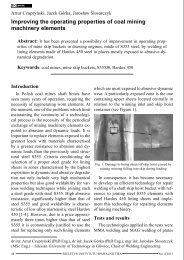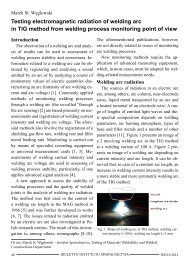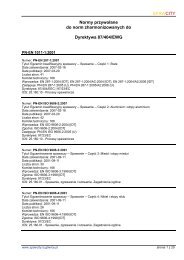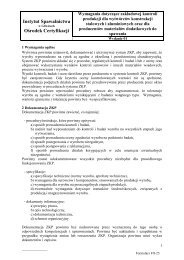Biuletyn Instytutu Spawalnictwa No. 01/2012
Biuletyn Instytutu Spawalnictwa No. 01/2012
Biuletyn Instytutu Spawalnictwa No. 01/2012
You also want an ePaper? Increase the reach of your titles
YUMPU automatically turns print PDFs into web optimized ePapers that Google loves.
in a wide range of currents was proposed in<br />
publication [2], in the form of a parallel connection<br />
of conductances corresponding to the<br />
nonlinear Cassie-Berger and Mayr-Kulakov<br />
models, whose participation is determined by<br />
appropriate tapering functions of current.<br />
The basic methods of controlling welding<br />
and electrothermal (arc and plasma-arc) devices<br />
include modifications of excitation source<br />
current as well as modifications of arc (length)<br />
voltage. Most of the simple and hybrid dynamic<br />
models applied so far, however, treat<br />
the arc as an element of the constant length<br />
of a plasma column. Moreover, there are even<br />
some cases when taking into consideration the<br />
modifications of the arc length only in relation<br />
to a single model (e.g. Cassie-Berger or<br />
Mayr-Kulakov) does not ensure that the approximation<br />
of power characteristics within a<br />
wide range of work current amplitudes can be<br />
obtained.<br />
Cassie-Berger and Mayr-Kulakov models<br />
of arc with constant plasma column<br />
length<br />
Dynamic models of an electric arc column<br />
are created on the basis of the power balance<br />
equation<br />
P<br />
= u<br />
i = P<br />
kol kol dys<br />
+<br />
dQ<br />
dt<br />
(1)<br />
where P kol<br />
– power supplied to the column,<br />
P dys<br />
– thermal power dissipated from the column,<br />
Q –thermal plasma enthalpy, u kol<br />
, i –<br />
voltage and current of the arc column. The<br />
effect of strong nonlinearity of the models<br />
results from column conductance variability,<br />
which is a composite function in the form<br />
of g(t) = F g<br />
(Q(t)).<br />
Popular electric arc models by Cassie-Berger<br />
and Mayr-Kulakov take advantage of two<br />
different simplifying assumptions [3]:<br />
• Mayr-Kulakov model: T(t,(x,y,z)) = variab.,<br />
arc power dissipated through conduction<br />
⎛ QV<br />
S(i)=const; σ(i)=var; P S (i)=const; g()<br />
i = K ⋅<br />
⎜<br />
1<br />
exp<br />
⎝ Q<br />
• Cassie-Berger model: T(t,(x,y,z))=<br />
const., arc power dissipated through convection,<br />
Q () i<br />
S(i)=var; σ(i)=const; P S (i) ~ Q(i) ~ g(i) =var; g()<br />
i = K<br />
where T – temperature, K; x,y,z – system coordinates,<br />
m; S – cross-section area, m 2 , σ- plasma<br />
conductivity, S/m; P S<br />
– dissipated power,<br />
W; Q V<br />
– plasma enthalpy volumetric density,<br />
J/m 3 ; Q 0<br />
– constant reference coefficient, J/m 3 ;<br />
K 1<br />
– constant coefficient of approximation<br />
with exponential function, S/m; K 2<br />
– approximation<br />
coefficient, S. As the Mayr-Kulakov<br />
model makes it possible to obtain the best approximation<br />
in cases when weak currents are<br />
required and the Cassie-Berger model in the<br />
case of strong currents, it is the latter model<br />
that is of basic importance in simulating electromagnetic<br />
processes in industrial welding<br />
and electrothermal devices. Transitory processes<br />
in the areas of the transition of current through<br />
zero values are significant for ensuring the<br />
stability of arc burning and appropriate start<br />
and stop characteristics. In addition, the processes<br />
are decisive for the proper operation of<br />
commutation devices.<br />
After adopting appropriate simplifying<br />
assumptions and transformations [3] from formula<br />
(1), one obtains the already known Cassie-Berger<br />
models<br />
- in the conductance form<br />
1 dg<br />
g dt<br />
2<br />
1 ⎛ u ⎞<br />
kol<br />
= ⎜ −1<br />
⎟<br />
2<br />
θC<br />
⎝ U<br />
C ⎠<br />
2<br />
( σ () i )<br />
⋅<br />
0<br />
V<br />
Q<br />
0<br />
⎞<br />
⎟<br />
⎠<br />
(2)<br />
16 BIULETYN INSTYTUTU SPAWALNICTWA<br />
NR <strong>01</strong>/2<strong>01</strong>2


